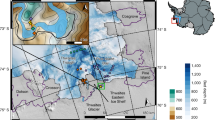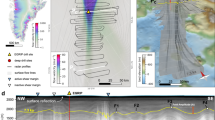Abstract
Water plays a first-order role in basal sliding of glaciers and ice sheets and is often a key constituent of accelerated glacier motion1,2,3,4. Subglacial water is known to occupy systems of cavities and conduits at the interface between ice and the underlying bed surface, depending upon the history of water input and the characteristics of the substrate5. Full understanding of the extent and configuration of basal water is lacking, however, because direct observation is difficult. This limits our ability to simulate ice dynamics and the subsequent impacts on sea-level rise realistically. Here we show that the subglacial hydrological system can have a large volume of water occupying basal crevasses that extend upward from the bed into the overlying ice. Radar and seismic imaging combined with in situ borehole measurements collected on Bench Glacier, Alaska, reveal numerous water-filled basal crevasses with highly transmissive connections to the bed. Some crevasses extend many tens of metres above the bed and together they hold a volume of water equivalent to at least a decimetre layer covering the bed. Our results demonstrate that the basal hydrologic system can extend high into the overlying ice mass, where basal crevasses increase water-storage capacity and could potentially modulate basal water pressure. Because basal crevasses can form under commonly observed glaciological conditions, our findings have implications for interpreting and modelling subglacial hydrologic processes and related sliding accelerations of glaciers and ice sheets.
This is a preview of subscription content, access via your institution
Access options
Subscribe to this journal
Receive 51 print issues and online access
$199.00 per year
only $3.90 per issue
Buy this article
- Purchase on Springer Link
- Instant access to full article PDF
Prices may be subject to local taxes which are calculated during checkout



Similar content being viewed by others
References
Zwally, H. J. et al. Surface melt-induced acceleration of Greenland ice-sheet flow. Science 297, 218–222 (2002)
van de Wal, R. S. W. et al. Large and rapid melt-induced velocity changes in the ablation zone of the Greenland Ice Sheet. Science 321, 111–113 (2008)
Iken, A. & Bindschadler, R. A. Combined measurements of subglacial water pressure and surface velocity of Findelengletscher, Switzerland: conclusions about drainage system and sliding mechanism. J. Glaciol. 32, 101–119 (1986)
Jansson, P. Water-pressure and basal sliding on Storglaciaren, Northern Sweden. J. Glaciol. 41, 232–240 (1995)
Fountain, A. G. & Walder, J. S. Water flow through temperate glaciers. Rev. Geophys. 36, 299–328 (1998)
Hodge, S. M. Direct measurement of basal water pressures: a pilot study. J. Glaciol. 16, 205–218 (1976)
Iken, A. Measurement of water pressure in moulins as part of a movement study of the White Glacier, Axel Heiberg Island, Northwest Territories, Canada. J. Glaciol. 58, 53–58 (1974)
Lappegard, G., Kohler, J., Jackson, M. & Hagen, J. O. Characteristics of subglacial drainage systems deduced from load-cell measurements. J. Glaciol. 52, 137–148 (2006)
Walder, J. S. & Hallet, B. Geometry of former subglacial water channels and cavities. J. Glaciol. 23, 335–346 (1979)
van der Veen, C. J. Fracture mechanics approach to penetration of bottom crevasses on glaciers. Cold Reg. Sci. Technol. 27, 213–223 (1998)
Sugiyama, S. & Gudmundsson, G. H. Short-term variations in glacier flow controlled by subglacial water pressure at Lauteraargletscher, Bernese Alps, Switzerland. J. Glaciol. 50, 353–362 (2004)
Hooke, R. L. & Pohjola, V. A. Hydrology of a segment of a glacier situated in an overdeepening, Storglaciaren, Sweden. J. Glaciol. 40, 140–148 (1994)
Iken, A., Echelmeyer, K., Funk, M. & Harrison, W. Mechanisms of fast flow in Jakobshavn Isbræ, West Greenland. Part I: measurements of temperature and water level in deep boreholes. J. Glaciol. 39, 15–25 (1993)
Engelhardt, H., Humphrey, N., Kamb, B. & Fahnestock, M. Physical conditions at the base of a fast moving Antarctic ice stream. Science 248, 57–59 (1990)
Harper, J. T. et al. Spatial variability in the flow of a valley glacier: deformation of a large array of boreholes. J. Geophys. Res. 106, 8547–8562 (2001)
Anderson, R. et al. Strong feedbacks between hydrology and sliding of a small alpine glacier. J. Geophys. Res. 109, F000120 (2004)
Brown, J. M., Harper, J. T. & Bradford, J. H. A radar transparent layer in a temperate valley glacier: Bench Glacier, Alaska. Earth Surf. Process. Landf. 34, 1497–1506 (2009)
Harper, J. T. & Humphrey, N. F. Borehole video analysis of a temperate glacier’s englacial and subglacial structure: implications for glacier flow models. Geology 23, 901–904 (1995)
Pohjola, V. A. TV-video observations of englacial voids in Storglaciaren, Sweden. J. Glaciol. 40, 231–240 (1994)
Harper, J. T., Humphrey, N. F., Pfeffer, W. T. & Lazar, B. Two modes of accelerated glacier sliding related to water. Geophys. Res. Lett. 34 10.1029/2007GL030233 (2007)
Boon, S. & Sharp, M. The role of hydrologically-driven ice fracture in drainage system evolution on an Arctic glacier. Geophys. Res. Lett. 30 10.1029/2003GL018034 (2003)
Das, S. B. et al. Fracture propagation to the base of the Greenland Ice Sheet during supraglacial lake drainage. Science 320, 778–781 (2008)
Krawczynski, M. J., Behn, M. D., Das, S. B. & Joughin, I. Constraints on the lake volume required for hydro-fracture through ice sheets. Geophys. Res. Lett. 36 10.1029/2008GL036765 (2009)
Fountain, A. G., Jacobel, R. W., Schlichting, R. & Jansson, P. Fractures as the main pathways of water flow in temperate glaciers. Nature 433, 618–621 (2005)
Clarke, T., Liu, C., Lord, N. & Bentley, C. Evidence for a recently abandoned shear margin adjacent to ice stream B2, Antarctica, from ice-penetrating radar measurements. J. Geophys. Res. 105, 13,406–13,422 (2000)
Ensminger, S. L., Alley, R. B., Evenson, E. B., Lawson, D. E. & Larson, G. J. Basal-crevasse-fill origin of laminated debris bands at Matanuska Glacier, Alaska, USA. J. Glaciol. 47, 412–422 (2001)
Woodward, J., Murray, T. & McCaig, A. Formation and reorientation of structure in the surge-type glacier Kongsvegen, Svalbard. J. Quat. Sci. 17, 201–209 (2002)
Lingle, C. S. & Fatland, D. R. Does englacial water storage drive temperate glacier surges? Ann. Glaciol. 36, 14–20 (2003)
Acknowledgements
This work was funded by the US National Science Foundation Office of Polar Programs, Arctic Natural Sciences.
Author information
Authors and Affiliations
Contributions
All authors contributed to developing the ideas presented. J.T.H. and T.W.M. conducted drilling and borehole experiments using drilling equipment designed by N.F.H. J.H.B. carried out radar and seismic experiments. J.T.H. drafted the manuscript, with all authors contributing to it.
Corresponding author
Ethics declarations
Competing interests
The authors declare no competing financial interests.
Supplementary information
Supplementary Information
This file contains Supplementary Figures 1-6 with legends, Supplementary Table 1 and additional references. (PDF 898 kb)
Rights and permissions
About this article
Cite this article
Harper, J., Bradford, J., Humphrey, N. et al. Vertical extension of the subglacial drainage system into basal crevasses. Nature 467, 579–582 (2010). https://doi.org/10.1038/nature09398
Received:
Accepted:
Published:
Issue Date:
DOI: https://doi.org/10.1038/nature09398
This article is cited by
-
Diurnal expansion and contraction of englacial fracture networks revealed by seismic shear wave splitting
Communications Earth & Environment (2021)
-
Diurnal, semidiurnal, and fortnightly tidal components in orthotidal proglacial rivers
Environmental Monitoring and Assessment (2018)
Comments
By submitting a comment you agree to abide by our Terms and Community Guidelines. If you find something abusive or that does not comply with our terms or guidelines please flag it as inappropriate.



